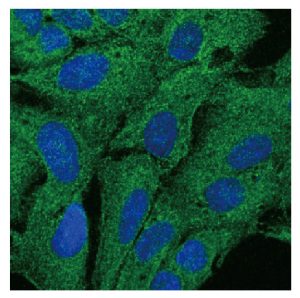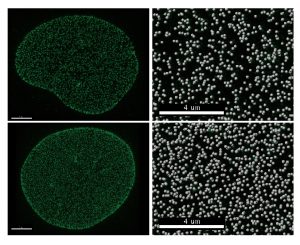
September 18, 2018
Salk scientists develop method to manipulate numbers of nuclear pores
Salk scientists develop method to manipulate numbers of nuclear pores
LA JOLLA—If the cell nucleus is like a bank for DNA, nuclear pores are the security doors around its perimeter. Yet more security doors aren’t necessarily better: some cancer cells contain a dramatic excess of nuclear pores.

Click here for a high-resolution image.
Credit: Salk Institute
Salk Institute researchers reported on September 18, 2018, in the journal Genes & Development that they have devised a way to manipulate numbers of individual nuclear pores—a breakthrough that may one day stop cancerous cells from proliferating out of control.
“Previously, we didn’t have the tools to artificially increase nuclear pores,” says lead author Martin Hetzer, who is also Salk’s vice president and chief science officer. “Our study provides an experimental avenue to ask critical questions: What are the consequences of boosting the number of nuclear pores in a healthy cell to mimic those found in a cancer cell? Does this affect gene activity? Why do cancer cells increase the number of nuclear pores?”
Nuclear pores are essential elements of all cells that provide controlled ways to move cellular material in and out of a nucleus. In organisms ranging from fungi to mammals, individual cells possess these transport channels that mediate a thousand events per second. Individual nuclear pores are fashioned from multiple copies of 30 proteins known as nucleoporins. Hetzer and colleagues looked at the nucleoporin Tpr, which has been implicated in certain cancers.
The team showed, for the first time, that each of the transport channels within a cell is unique, and each cell nucleus possesses a specific number of nuclear pores. Next, the team used molecular methods to remove Tpr to see its effect on the number of nuclear pores, with a surprising result.

Click here for a high-resolution image.
Credit: Salk Institute
“Typically, when you ‘knock down’ or remove some of the proteins that make up the nuclear pore complex, the total number of nuclear pores goes down,” says Asako McCloskey, first author of the paper and a Salk research associate. “Our surprising finding was that when we get rid of the nucleoporin Tpr, nuclear pore numbers went up dramatically.”
“This is the first time that modifying a component within the transport channel has been shown to increase the number of nuclear pores,” adds Hetzer.
This indicates that Tpr plays a role not in transport itself, but in regulating the assembly of nuclear pores. The knowledge could be crucial for future attempts to manipulate numbers of nuclear pores to treat disease. For example, cells with higher metabolic activity—such as stimulated thyroid follicular cells or aggressive tumors—have more nuclear pores per nucleus. Other research has shown that stopping cancer-related “cargo” proteins from being transported through the nuclear pores can lead to dramatic effects in cancer treatment. Targeting nuclear pores could also negate aggressive cancer’s resistance to multiple drugs, as higher numbers of nuclear pores in tumor cells allow them to export chemotherapy out of the nuclei.
Next, the lab will use the new technique to pinpoint the effects of tweaking nuclear pore numbers in a variety of cell types.
The paper’s other author is Arkaitz Ibarra, a scientist at Molecular Stethoscope in San Diego.
The work was funded by the National Institutes of Health, the Helmsley Center for Genomic Medicine, the Nomis Foundation and the Glenn Center for Aging Research.
JOURNAL
Genes & Development
AUTHORS
Martin Hetzer, Asako McCloskey and Arkaitz Ibarra
Office of Communications
Tel: (858) 453-4100
press@salk.edu
Unlocking the secrets of life itself is the driving force behind the Salk Institute. Our team of world-class, award-winning scientists pushes the boundaries of knowledge in areas such as neuroscience, cancer research, aging, immunobiology, plant biology, computational biology and more. Founded by Jonas Salk, developer of the first safe and effective polio vaccine, the Institute is an independent, nonprofit research organization and architectural landmark: small by choice, intimate by nature, and fearless in the face of any challenge.